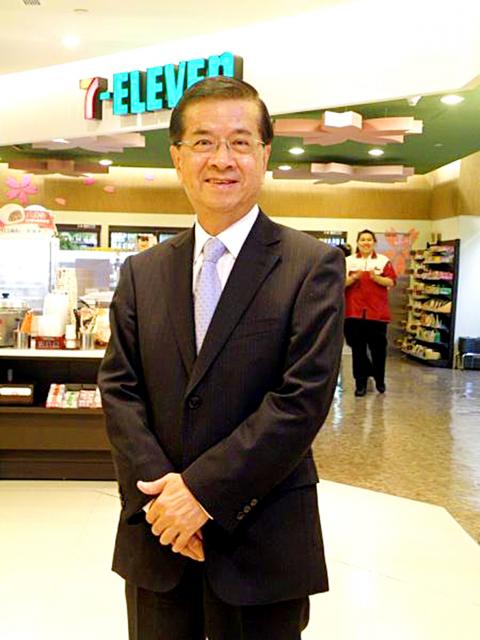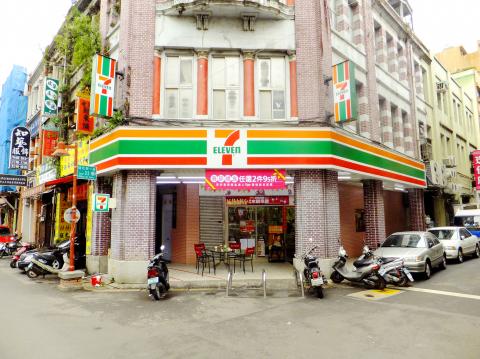Feb. 5 to Feb. 11
It’s hard to believe that today’s ubiquitous 7-Eleven was once labeled as the “prodigal son of Uni-President Enterprises Corp.” But during its early days, the convenience store cost the corporation more than NT$2 billion in total losses.
Launching its first store in February 1980 on Taipei’s Changan E Road, the venture had already eaten into about half the original capital of NT$1.9 billion by September 1982.

Photo: Yang Ya-min, Taipei Times
“Besides Uni-President, other shareholders had little desire to keep the stores running,” Lee Jen-fang (李仁芳) writes in the book, 7-Eleven Takes Over Taiwan (7-Eleven 統一超商縱橫台灣).
At the same time, foreign and local investors bombarded Uni-President with calls about acquiring the stores. But the corporation refused all offers, instead buying out the other shareholders and taking full control over the venture by incorporating it into the company as its “supermarket department.”
It would take several more years for the company to finally turn a profit, but this was the beginning of its 7-Eleven empire in Taiwan.

Photo courtesy of Wikimedia Commons
RISE OF THE MINIMART
The late 1970s saw the rise of the two food giants of Uni-President Enterprises Corp (UPE, 統一企業) and Wei Chuan Foods Corp (味全食品) in response to increased competition in the consumer market.and need for more streamlined and efficient operations.
However, the first mini-market chain was launched by the Council of Agriculture, Taipei City Government and Youth Development Administration in 1977. According to the a 60th Anniversary publication by Wei Chuan (who later purchased the chain), government officials launched this venture after visiting the US and noticing how clean their supermarkets were compared to the traditional markets of Taiwan.
In 1979, UPE simultaneously opened 14 “modern convenience stores” across the country. Run as a subsidiary, the company held half the shares and gave the rest to dealers, family and friends. The corporation not only wanted to create a clean and bright shopping experience, but also hoped to have complete control over the channels of distribution for its products by running its own stores.
It was a daring venture as the average annual income was less than US$2,500 back then, says Hsu Chung-jen (徐重仁), who played a key role in the rise of 7-Eleven.
“As a food producer, Uni-President jumped straight into the unfamiliar world of retail and chain stores, and opened 14 stores at once with the intent of opening more. They did not even understand the basic differences between an independent store and a retail chain,” he says.
Hsu says they started out working almost 20 hours a day. He and two colleagues borrowed two desks at the parent company to conduct business, but when the company needed the desks they were relegated to a couch by the receptionist.
Hsu adds that the stores struggled because they were not able to fully identify customer needs.
“To fulfill the one-stop-shop needs of our customers, if someone wanted a broom we would start selling brooms. By the end, we had seven or eight types of detergent and milk formula and even sold vegetables, fresh meat and fish,” Hsu says.
GROWING PAINS
Hsu tried to collaborate with US corporations, but talks were stalled due to the US cutting diplomatic ties in 1979. Finally, Southland Corporation, which ran 7-Eleven in the US, reached out and the two companies signed a deal to run the stores under the 7-Eleven module and moniker.
Southland’s directive was to establish uniform, modern stores that would eventually replace traditional “mom-and-pop” businesses. They targeted housewives primarily and the initial stores were all located in residential areas. As its name suggests, the initial stores opened at 7am and closed at 11pm. And like its US counterparts, it sold Slurpees and other signature items.
However, Hsu noticed that due to the different nature of residential areas in the US and Taiwan, the US-mandated module was not attracting as many customers as they expected. Their prices were also higher — and Taiwanese housewives then were much more sensitive to prices than their US counterparts.
In 1981, the stores experimented with 24-hour service, but its products did not attract late night shoppers and soon reverted to its original hours. The franchising module did not work either as it was uncommon in Taiwan at that time.
Hsu wanted to localize the stores by eschewing the Western fast food for tea eggs and meat buns, but Southland objected on the grounds that it would ruin the image of the store. Hsu insisted, and tea eggs are a staple of all convenience stores today.
The store experienced massive losses, but still had the full support of management. Hsu returned to the fold after a short departure and got rid of 35 underperforming locations, mostly in residential communities. They analyzed the sales revenue from each store and were confident enough in 1983 to make one of the stores permanently 24-hours.
The evolution continued from there. As more women went to work, 7-Eleven in 1985 launched its signature series of microwavable meals. It opened stores in more visible areas and poured money into advertising, also adjusting its target market to the 18 to 35 crowd who were less sensitive to higher prices.
In 1986, six years after the initial venture, the chain made a profit for the first time. There was still a long road to climb, but 7-Eleven was the prodigal son no more.
“We can make up what we lost during those six years in a month or two now,” the late Uni-President founder Kao Ching-yuan (高清愿) said in 1995.
Today, there are 5,235 7-Elevens across the nation, and UPE just opened its first staffless store at their headquarters in Taipei on Monday.
Taiwan in Time, a column about Taiwan’s history that is published every Sunday, spotlights important or interesting events around the nation that have anniversaries this week.

This is the year that the demographic crisis will begin to impact people’s lives. This will create pressures on treatment and hiring of foreigners. Regardless of whatever technological breakthroughs happen, the real value will come from digesting and productively applying existing technologies in new and creative ways. INTRODUCING BASIC SERVICES BREAKDOWNS At some point soon, we will begin to witness a breakdown in basic services. Initially, it will be limited and sporadic, but the frequency and newsworthiness of the incidents will only continue to accelerate dramatically in the coming years. Here in central Taiwan, many basic services are severely understaffed, and

Jan. 5 to Jan. 11 Of the more than 3,000km of sugar railway that once criss-crossed central and southern Taiwan, just 16.1km remain in operation today. By the time Dafydd Fell began photographing the network in earnest in 1994, it was already well past its heyday. The system had been significantly cut back, leaving behind abandoned stations, rusting rolling stock and crumbling facilities. This reduction continued during the five years of his documentation, adding urgency to his task. As passenger services had already ceased by then, Fell had to wait for the sugarcane harvest season each year, which typically ran from

It is a soulful folk song, filled with feeling and history: A love-stricken young man tells God about his hopes and dreams of happiness. Generations of Uighurs, the Turkic ethnic minority in China’s Xinjiang region, have played it at parties and weddings. But today, if they download it, play it or share it online, they risk ending up in prison. Besh pede, a popular Uighur folk ballad, is among dozens of Uighur-language songs that have been deemed “problematic” by Xinjiang authorities, according to a recording of a meeting held by police and other local officials in the historic city of Kashgar in

It’s a good thing that 2025 is over. Yes, I fully expect we will look back on the year with nostalgia, once we have experienced this year and 2027. Traditionally at New Years much discourse is devoted to discussing what happened the previous year. Let’s have a look at what didn’t happen. Many bad things did not happen. The People’s Republic of China (PRC) did not attack Taiwan. We didn’t have a massive, destructive earthquake or drought. We didn’t have a major human pandemic. No widespread unemployment or other destructive social events. Nothing serious was done about Taiwan’s swelling birth rate catastrophe.